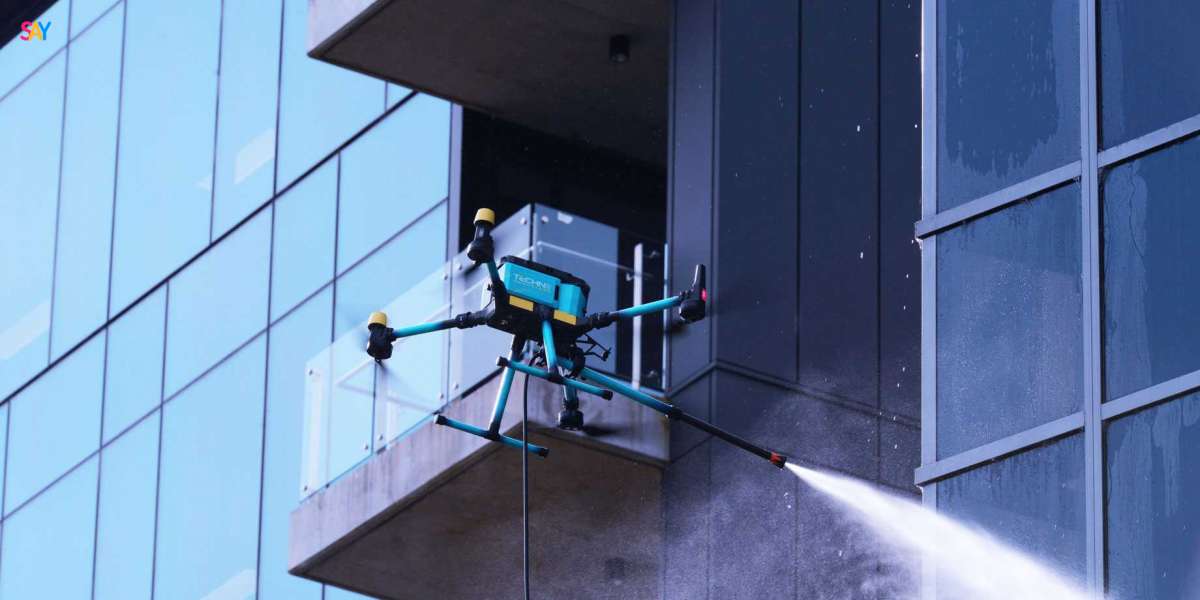With technology evolving every day, industries are looking for smarter, faster, and safer ways to complete tasks. One of the most exciting innovations in recent years is drone cleaning. From tall buildings to hard-to-reach solar panels, drones are transforming how we clean and maintain structures. Among the most popular applications is the solar panel cleaning drone, which offers an efficient, cost-effective, and environmentally friendly way to keep solar panels performing at their best.
In this blog, we’ll explore how drone cleaning works, the benefits it offers, and why solar panel cleaning drones are gaining popularity in both residential and commercial settings.
What is Drone Cleaning?
Drone cleaning is the use of specially designed unmanned aerial vehicles (UAVs), or drones, to clean hard-to-access surfaces like windows, rooftops, building facades, and solar panels. These drones are equipped with water tanks, brushes, sprayers, and sometimes even high-pressure nozzles, depending on the application.
The main goal of drone cleaning is to:
- Improve safety by reducing the need for workers to climb
- Save time and labor costs
- Access places that are difficult or dangerous to reach
- Provide consistent, high-quality cleaning
How Drone Cleaning Works
Drone cleaning technology combines flight control systems, GPS navigation, and specialized cleaning attachments to perform cleaning tasks. The process generally involves:
- Site assessment and planning
Operators evaluate the area, note obstacles like power lines or trees, and program the drone’s flight path. - Drone preparation
The drone is fitted with the appropriate tools: water tanks, brushes, or sprayers, depending on the job. - Flight and cleaning
The drone flies along the surface being cleaned, spraying water, using rotating brushes, or applying eco-friendly cleaning agents. - Live monitoring
Operators monitor the cleaning in real-time using cameras and sensors, ensuring thorough and even coverage. - Post-cleaning inspection
Drones may be equipped with cameras to take photos or videos after cleaning, helping with inspection and documentation.
Benefits of Drone Cleaning
Using drones for cleaning provides several benefits that traditional methods cannot match.
- Improved Safety
Cleaning tall buildings or solar panels on roofs traditionally requires ladders, scaffolding, or rope access—putting workers at risk. Drones eliminate the need for human workers to be in dangerous positions.
- Time Efficiency
Drones can clean large areas in a fraction of the time it takes manual cleaners. This is especially useful for commercial buildings, solar farms, and high-rise properties.
- Cost-Effective
Less equipment, fewer workers, and quicker job completion mean reduced overall costs for building managers and homeowners.
- Eco-Friendly
Many drone cleaning services use minimal water and biodegradable cleaning solutions, reducing environmental impact.
- Consistent Quality
Drones follow pre-programmed paths and apply even pressure and coverage, leading to more consistent results compared to manual cleaning.
The Rise of Solar Panel Cleaning Drones
Solar energy is becoming increasingly popular around the world. However, dirty solar panels can lose up to 20–30% of their efficiency. Dust, bird droppings, leaves, and pollution can block sunlight and reduce power generation. Regular cleaning is essential, but traditional methods can be risky, expensive, or impractical—especially in large solar farms or rooftop installations.
This is where the solar panel cleaning drone comes in.
What is a Solar Panel Cleaning Drone?
A solar panel cleaning drone is a specially designed drone equipped with gentle sprayers, soft brushes, or air blowers to clean solar panels without damaging their surface. These drones are lightweight, easy to operate, and designed to clean panels in a safe, non-contact or low-contact manner.
Features of Solar Panel Cleaning Drones
- Lightweight and non-abrasive brushes
- Water tanks or mist sprayers for gentle cleaning
- GPS-guided navigation for precision
- Camera systems for inspection and monitoring
- Long battery life for extended operation on solar farms
- Solar-powered charging stations (in some models)
Advantages of Using Drones for Solar Panel Cleaning
- Damage-Free Cleaning
Solar panels are delicate. Drones are designed to clean gently without scratching or cracking the glass surface.
- No Need for Heavy Equipment
Traditional cleaning often requires ladders, scaffolding, or robots that are bulky and time-consuming. Drones eliminate that need.
- Ideal for Remote or Large Installations
For ground-mounted solar farms or rooftop panels in rural areas, drones can access and clean panels quickly, even in hard-to-reach places.
- Reduces Water Waste
Drones use just enough water to clean efficiently, avoiding waste and run-off.
- Automated Scheduling
Some drone systems can be programmed for scheduled cleaning, allowing solar panel owners to automate maintenance throughout the year.
Where Are Solar Panel Cleaning Drones Being Used?
These drones are becoming common in several areas, such as:
- Residential rooftops
- Commercial buildings with solar panels
- Agricultural farms
- Industrial solar power stations
- Remote off-grid installations
In dusty areas or near factories and highways, panels accumulate dirt more quickly, making drone cleaning even more important.
Challenges and Considerations
While drone cleaning technology offers many benefits, there are also some challenges:
- Initial Cost
Investing in drone equipment or hiring drone cleaning services may seem costly at first, but the long-term savings in labor and maintenance often make up for it.
- Weather Conditions
Strong winds, rain, or extreme heat can interfere with drone operations. Proper planning and weather checks are essential.
- Training and Certification
Operators must be trained, licensed, and follow aviation rules, especially in populated areas.
- Battery Life
Drone flight time is limited by battery life, so large installations may require multiple flights or drones.
Future of Drone Cleaning and Solar Maintenance
As drone technology advances, we can expect to see even smarter and more efficient solutions. Some future trends include:
- AI-powered drones that can detect dirty panels automatically
- Self-charging drones using solar energy
- Integrated cleaning and inspection drones that clean and check for damage at the same time
- Data collection and analysis to optimize solar system performance
The future of drone cleaning is not just about cleaning—it’s about intelligent maintenance, automation, and sustainability.
Final Thoughts
Drones are redefining how we clean and maintain the structures around us. From skyscraper windows to vast solar farms, drone cleaning offers a smarter, safer, and more effective solution. In particular, the use of solar panel cleaning drones ensures that panels stay efficient, clean, and productive—without the need for risky manual labor.
Whether you own a few solar panels on your home or manage a large solar farm, investing in drone cleaning is a smart move for long-term performance and cost savings.




